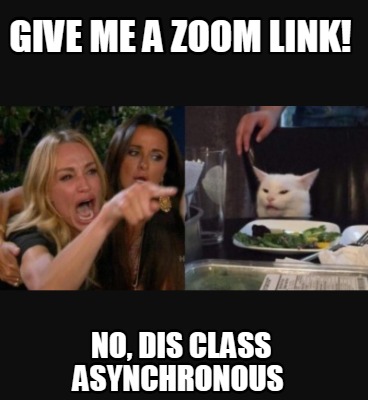Good online learning – asynchronicity

Following on from the last post about group work, I’m continuing my series (2 posts constitutes a series, right?) on trying to counter the negative views of online learning by highlighting positive aspects. In this post I want to look at an element that is, in my view, often overlooked – the ability to structure learning that is asynchronous in delivery but retains aspects of interactivity, collaboration and community.
Much of face to face learning is based around the often unquestioned assumption of synchronous delivery. A student has to be present at a set time for a lecture, seminar, lab session, or exam. Traditional distance learning (largely print based) started from an assumption of asynchronous study (with some synchronous events such as tutorials and summer schools). This has then followed through into the design of early online education. The online pivot in contrast was largely defined by the need to replicate the synchronous model online.
It is interesting (to me anyway) that we used to talk of Asynchronous Learning Networks (ALNs), and a lot of early elearning literature was focused on the asynchronous nature of online learning. This was partly a product of the limitations of the technology (you couldn’t do reliable video chat back in 1998), but also speaks to some of that early desire to rethink what education would look like online. The advent of reliable video streaming has meant people have become lazy and just shifted existing practice online.
It might not be overstating things to say that asynchronous vs synchronous is a more significant consideration than face to face vs online. And this gets to one of the issues with the criticisms of online learning, the lecture deficit model, which is simply attempting to replicate the synchronous model. Before we look at blending the two (which is probably optimal), let’s consider how asynchronous online education is realised.
It makes use of extensive (if not exclusively) online material – VLE content, videos, blogs, podcasts, etc, often creating a rich mix of media and sources. It will use text based forum discussions, which may be split into different levels – for example ones for whole cohort discussion, tutor groups, specific group work projects, etc. Blogs, wikis, and other tools can be used for co-creation and commenting.
None of that is rocket science of course, but it does require a higher degree of intentional learning design than the conventional lecture series. See for example, the considerations around group work I mentioned in the last post. But asynchronous delivery offers a number of distinct advantages over the synchronous model, for instance:
- Increased student flexibility – not being required to be present at exact times allows greater flexibility for students, which becomes increasingly important as more of the student body are working, caring or have other commitments. Even the use of lecture capture which allows a degree of asynchronous study is valued by students for improving note taking, independence and self-pacing.
- Greater student control – related to the above, asynchronous study allows students to spend as long or as little as they need on certain subjects.
- Time to interact – asynchronous discussion gives students time to construct and research answers, making interaction more productive for many.
- Increased curriculum flexibility – one of the limiting factors in multidisciplinary study is the tyranny of the timetable. This is under-appreciated I feel. We can’t combine many combinations of subjects because the logistics of creating timetables for lectures becomes exponentially complex. Asynchronous study does not have this limitation, so for instance on our Open degree, students can combine over 250 different modules to create their own degree. You can’t do that with synchronous based study.
I am over-simplifying things here to make a point – it is not really asynchronous vs synchronous. In reality it is usually a blend – lots of on campus education is asynchronous already, for instance reading lists, lecture capture, VLE content. And a lot of asynchronous online content has synchronous (or semi-synchronous) elements, for example online tutorials, guest speakers, assessment.
This is all sensible design and making the best use of each medium. The point here is rather that online learning offers a greater opportunity to implement effective asynchronous learning, and that has a number of advantages. So we shouldn’t just replicate the synchronous model online and disregard those opportunities.

3 Comments
dave
For the rest of their lives, 97.2% of the work that students will do will be ‘asynchronous’. Stands to reason we might want to work some of that into their education.
mweller
But meetings, Dave, meetings.
Pingback: